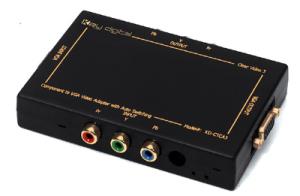Introduction
Although just about any new digital projector you
purchase now will have DVI, HDMI, or YPbPr component video inputs, the
projectors of the past used RGBHV (H stands for Horizontal Sync, and V
stands for Vertical Sync). These high end projectors, usually CRT, were capable of very high
resolutions, some as high as 1080p.
As time has passed, companies moved
to the Component Video format, YPbPr, which DVD players use predominantly.
So how do you glue Component Video
sources to high end CRT projectors? Key Digital's ClearView3 CTCA3
Transcoder is the answer.
Component Video (YPbPr)(YCbCr)
Component Video, found on just about every DVD and
HD source is a compressed video stream. It is calculated from the original RGB (native) source as follows:
Y = + 0.299R + 0.587G + 0.114B
Pb/Cb = +(B - Y) / 1.772 + 0.5
= - 0.168736R - 0.331264G + 0.5B + 0.5
Pr/Cr = +(R - Y) / 1.402 + 0.5
= + 0.5R - 0.418688G - 0.081312B + 0.5
Here, R, G, and B are assumed to
range from 0 to 1, with 0 representing the minimum intensity
and 1 the maximum. YCbCr was defined in the ITU-601 standard
for use with digital component video. The same color space
for use in analog component video was called YPbPr,
although the term YCbCr is often used for both systems.
Where Y carries the luminance, the PbPr carries the color
space difference encoding.
RGB Video (RGB)(RGBHV)(RGBs)(RGsB)
RGB video can be organized with different synch
configurations to create the four recognized RGB formats. These formats keep
true RGB information in separate signals without compression, and each component
has full luminance information. RGBHV carries the synchs on separate signal
wires. In essence, RGB video is the best possible analog video format, as
there is no signal compression.
The "Glue"
Since YPbPr is derived from RGB using known
formula, it is then possible to restore the signal to RGB format by doing
what is called transcoding. This is done by restoring each RGB signal, and
restoring the synch to the RGB or RGBHV format. While some information is
lost from the original compression to Component Video, the result is video
quality that is equivalent to the component signal but in a format that
"legacy" RGB display devices can understand.
The Key Digital ClearVideo3 CTCA3 provides for color space
correct transcoding of component signals to RGB. It's a small but powerful
device. Not much larger than a deck of cards, this single device brought HDTV
to my Runco DTV-933 projector. It's simple to use. I connected my Dish 811
receiver to the component input, and the projector to the RGB output. The
CTCA3 is configured for RGBHV out of the box. I powered it on, selected
720p on my dish receiver (this produces the best image) and created a profile
for it, using 720p, in my projector.
That was it. It worked flawlessly. There was no more
configuration, no fiddling. Just 5 minutes of plug and go. I later connected
the RGBHV output of my Runco scalar to the RGB pass-through. This way,
when I wasn't watching HD, the unit would pass through my scalar's signal
automatically. The unit also provides for a Component Video pass-through.
While I cannot do a direct comparison (my projector
only accepts RGBHV), I can say that the unit performed very well. The colors
looked spot on, there was no loss in black level or blacker-than-black. I
didn't see any color clipping. The 1080i picture was far superior than that
of my up-converted DVD signal from my Runco scalar.
Conclusions
The Key Digital ClearView3 (CTCA3) will become an
essential part of my reference theater. Only a very select few of the very
high end processors provide transcoding as part of their package. As more
processors focus on HDMI, DVI, and digital displays, the CTCA3 will become
invaluable as we CRT users upgrade our video processors to the latest
technology.
- Brian Weatherhead -




